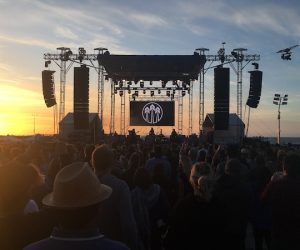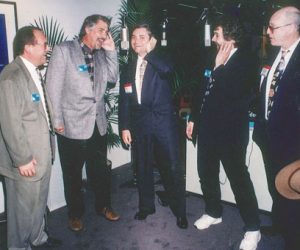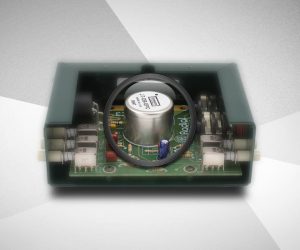
Garbage Live
A Garbage gig is as loud as any going around. On stage it’s a very different story. No amps, no wedges, almost no acoustic drum sound… Christopher Holder talks to the engineers behind the world’s biggest rock’n’roll paradox.
Garbage’s FOH engineer, Tom Abraham and his crew had an idea. They thought: “why not take advantage of the advances in in-ear monitoring to clean up the stage sound?”. The plan was to remove all the guitar amps and floor monitoring. The amps would be replaced by Line 6 Pods while the drums would use triggers to talk to a d-drum system. Apart from Butch Vig’s miked-up cymbals, the result would be a ‘silent’ stage. By which I mean, if you turned off the PA in the middle of the gig all you’d hear in the front row would be the splash and sizzle of the crash and ride and an acoustic vocal.
If I told you that Tom and co. made this idea work earlier this year, that’d be impressive enough… but the fact is, Garbage have been working in this manner with enormous success for a total of eight years now!
What’s more, this isn’t some low-key semi-acoustic ensemble where the vocalist chills on a barstool and ‘drums’ consist of a beardy bloke rattling an egg shaker… this is Garbage. This is a band that rocks hard and plays flat-out, 100 miles an hour shows.
SOMETHING WE PREPARED EARLIER…
Needless to say, getting ready for a worldwide tour that works in this way takes preparation. Sounds used on the albums are sourced and programmed; settings for the racked up ‘backline’ are configured, then re-configured… Prior to a tour, Garbage is in preproduction for a month or more honing its sound. There might be obvious sonic advantages working on a quiet stage (more separation in the FOH mix, more headroom for the vocal) but no one is saying it’s easy to achieve…
Tom Abraham: Rehearsals for this tour were made tougher thanks to our schedule. Without much notice we had to assemble three sets of control gear, three sets of backline and spread those out over the world while we were rehearsing. The actual rehearsal time was cut by having to deal with all that. Which was un fortunate. It meant the band only had time to rehearse and get a minimum number of songs together. We were able to prepare 15 songs and that’s it… which has made playing encores difficult!
Christopher Holder: I imagine it’s hard enough to keep tabs on one set of gear let alone three?
TA: Just about all our stuff is programmable. There’s very little gear that we need to physically dial settings into. In theory, that should make the process easier, but you’d be surprised how the programmability thing doesn’t offer the certainty you might expect. Settings that should be exactly the same aren’t always exactly the same. We ran into that with a few things like: why is this Bass Pod’s volume here at 6 o’clock and why is this other one at 9 o’clock? Little things, but mystifying nevertheless.
CH: So what is this tour’s ‘backline’ comprised of?
TA: The drum kit has DW triggers all over it and a d-drum brain. Both guitar racks are basically the same. They’re both based on [Line6] Pod Pros, and TC Electronic G-Force guitar processors. The bass guitar uses a Bass Pod Pro. For keyboard sounds we use Muse Receptor modules – with iLoks. The DIs and guitar wirelesses are in the racks as well.
There’s a lot of programming stuff to keep an eye on. All of the settings are on cards and are all on people’s computers. Every time you update one lot, it’s got to be carried over to the others. Which all sounds fraught with danger, but we’ve had less technical hiccups on this tour than ever before. I think it’s a case of the software being far more stable and any hiccup is no different to the failure you get with any piece of conventional gear.
CH: Last time AT spoke to you [issue 23], you were using an analogue console and now I see you’re packing a Digico D1.
TA: Traditionally, I’ve always mixed this band on a Soundcraft Series 5. But I love mixing on the Digico and I hope to never mix on anything else in the foreseeable future. It’s so much better than an analogue desk. Everything about it is better.
CH: Even sonically?
TA: Even sonically. Some people will say that a digital desk doesn’t sound as good. But for a live gig I’d disagree with that – I don’t think you can actually hear the differences made by the console’s circuitry. One difference that is discernable is not sending all that audio back and forth down 600 feet of copper.
With the Digico, there’s no audio at FOH, it’s all data flow. And the mix goes down the optical cable to the stage box. That’s noticeable to me. The sound of the DI’s and mics are more open. And once you cumulate that openness over several channels it does make a difference.

CH: For a band that’s at the vanguard when it comes to dispensing with the traditional accoutrement of touring, a digital console feels like a good fit. Is that the case?
TA: It is a good fit. I love to minimise the crap I need to cart around with me. The rack I keep is mainly dedicated to Shirley’s vocal. I have four frequency-dependent compressors on her voice. It’s actually the compressor in the TC Gold Channel. They’re the only one that has two modes – they run in Absolute, or Relative Absolute, like a BSS 901. What happens is that the threshold floats, so if you make a quiet ‘ess’ or a loud ‘ess’ it de-esses the same amount.
The other reason for using the Gold Channels is because of their digital I/O. I make a point of using all-digital outboard gear – AES/EBU all the way. That way it picks the wordclock up off the desk and you’re not doing any goofy-assed stuff like making the signal analogue then going analogue-analogue-analogue-analogue and then back into digital to do an insert. I’m just sending the data on a different path and coming back into the desk. Which is really nice for cleanliness and really nice for metering – the thru-pass metering actually means something because it’s consistent.
CH: And the longer you maintain a digital signal path throughout, the more flexible the routing?
TA: It’s very easy to do anything that’s thrown at you with this desk without running around trying to find extra gear and cables – which I really like. Take for example, when Shirley recently sang with that Peaches girl. I didn’t need another compressor, I didn’t need another Y cable, I didn’t need to find another channel somewhere, I just put her on a channel next to Shirley, put a compressor over it, some EQ… and there it was. I never even got out of my chair.
Or, I can create a completely different broadcast mix from the L/R mix. Because the matrix is just another part of the desk, it just addresses an input in the same way that a channel does. I can pull every single input individually into the matrix at a different balance to the L/R mix and create a completely different broadcast mix. It has the same processing and EQ, and follows your mix moves, only in this case the internal balance of the matrix inputs are different to that of the L/R mix. I then just need to run it digitally out to a Waves L2 to compress it a lot more than I would on a PA mix and it’s right for TV.
CH: How do you mix a Garbage show on the Digico D1? How do you exploit the automation?
TA: I mix really conventionally. At the start of the day I recall my saved session and then it’s like an analogue desk from that point on. Personally, I’ve never had much luck with scene change moves. How far you throw things during a song is really relative to how it’s going in the room. A guitar solo at +2 might be really ripping one day, and the next day, at +10, you might hardly hear it. So a scene change isn’t doing you any good in that case.
What I do get from the automation is the consistency of a starting point. At the end of a particularly difficult show my mix may have gone to some place weird, but I haven’t ripped my mix apart on the desk in the process – I just throw that one away, and recall it from scratch the next day. That’s what’s awesome about it.
When you find yourself using an analogue rig, you’re less inclined to do stuff because you’re going to have to put it all back at a later date. Say if you’re playing club gigs night after night and then the next day you’re in a dome with a floating roof – you can’t hear anything, and you’re compelled to destroy the desk you’re touring with to pull some sort of sound. Afterwards, you almost need a day of preproduction to get it back. But now, it doesn’t matter; you can start afresh the next day… or save that Dome gig as a different session.
CH: But are you using the D1 to set up radically different one-off effects etc?
TA: I can do stuff on this desk that’s more painful to do on an analogue desk. For instance, I can very simply grab my kick, snare and bass, replicate them into three more channels, treat them totally differently: compress them to hell, EQ them totally differently and then mix them back in without any Y cables or extra inserts. Super easy to do, but a patching pain in the ass on a regular rig.
There’s also the joy of being able to make the stage totally silent because I have a gate available on every channel. They’re all engaged; they just sit there at –50. Any little hum or buzz that might be flying around, you just don’t hear anymore. You get so used to how quiet it is.

SAMSON DELIGHTS HER
CH: Can you run me through your stage setup?
TA: For DIs, I’m using the passive Jensen transformer-based JDI. They have a nice sound. They’re a little pricey and they’re kinda low gain, but they have a nice tone. You never have hum or buzz problems.
I use two Audio-Technica 4050s as overheads on the drums in figure-8 pattern. They’re just kinda lobbed in behind the Plexiglas [that baffles the drums’ cymbals]. It’s so loud behind there that you can stick a mic wherever.
For the vocal, Shirley still sings into a Samson wireless mic with an Audix OM5 head like she always has. Nothing sounds better on her. Everyone’s given us all kind of stuff to try but I tell you what, on her, that thing is an absolute warrior in a hostile gig environment. It’s not the best-sounding mic, but it’s possible to make it sound good – you just have to massage it a bit. But when things get ugly you can get her vocal up front with that thing, and she prefers the sound of it in her ears.
It’s the same UHF system that Samson had out in 1992. We go everywhere with it and it’s as predictable and as solid as a rock. Still, no one knows about them, no one buys them. People think Samson makes rubbish. In fact, I believe it’s about the last thing that Samson made that costs good money – they’re about US$1800 for a package. They were going to discontinue the system, but we started using it on Marilyn Manson’s tour and he was going through them like underwear because of what he does. So we got him to buy about 50 to 100… so I think that prompted Samson to start making them again.
CH: Do you work the vocal quite hard in the mix?
TA: I ride the crap out of the vocal and I never leave it sitting open. In Marilyn Manson’s case it’s absolutely mandatory. But with all the frequency-dependent compression going on with Shirley’s vocal I don’t like leaving it open either. It’s a loud rock show and that mic is really loud, so you don’t want to leave it open. It means you need to keep an eye on her. Same goes for Marilyn Manson. The whole show I’m watching him. You have to watch what he’s doing because you don’t know when he’s going to sing… or scream, or throw the mic… You have to watch.
The Garbage shows you mix. The Marilyn Manson show is more like damage control. It’s full crushing. To just get the PA 3dB louder than what’s coming from the stage… you’re at a pretty stunning volume level.
But I enjoyed it because it’s one of the last bastions of excess. You don’t get shows like that much anymore. It thrives almost on the fear element of it. I kept out of trouble during the tour and just mixed the show.
CH: No ritual goat slaying?
TA: No. Just out-of-control partying.
SILENCE IS GOLDEN
CH: In your experience have you noticed more of a move to quiet stages?
TA: I’m still yet to see another absolutely silent stage. I see a strange combination of monitors and IEMs, which I’ve never understood – that just doesn’t work in my opinion. I’ve never understood why so many people do that because it’s such a mistake. There are so many time problems associated with that – there can easily be a 40ms delay between your ears and side-fills!
CH: Do you record gigs for later reference?
TA: I do. I’ve taken to using the new Tascam DV-RA1000 DSD recorder [see Issue 42 for AT’s review]. That’s cool. You take a data dump off the D5 or D1 at 24-bit/48k. So you set up a 24/48 session and then just hit Record. It dumps an enormous wave file onto the DVD. Then you can give it to your ProTools guy, he imports that in and does what he likes with it. At that data rate you can get two entire shows on DVD – it’s a cheaper, more convenient medium than DAT now.
CH: DAT’s still been prevalent for want of a viable alternative I guess?
TA: Everyone uses DAT because it’s the only medium you can get a two-hour show onto. But now so few people use DAT that the tape has become very expensive. And it’s still only 16-bit in most cases, and definitely doesn’t sound as good as a 24-bit recording. The other problem is, if you actually want to use the DAT it needs to be dumped into ProTools in real time, while importing it off DVD only takes a minute.
CH: And the DV-RA1000 is robust enough?
TA: It lasted all the way through our European tour. Worked perfectly. It’s a very nice-sounding unit. I’m very impressed with it.
CH: Anything else on the Tom Abraham radar, technology-wise?
TA: I’m looking into running plug-ins from the Digico console. There’s no interface for the plugs on the D5, so I’d need to use a separate rackmount computer, and use the PC’s interface and processing power to run the plug-ins via MADI back into the desk. Which is great because I have two Waves L2s in my rack and I can get rid of those. Again, less crap to cart around. I also like the idea of being able to use the McDSP plugs for my frequency-conscious compression. I wouldn’t need the Gold Channels anymore.
I like getting rid of all that stuff.




MONITORS – VORACIOUS
Christopher Holder: A ‘quiet stage’ with everyone on in-ear monitors… it all sounds like a monitor engineer’s idea of heaven. What are the main challenges?
Clay Hutson: The hardest part and the easiest part of my job comes down to one thing: Shirley Manson. She’s voracious. She’s a voracious singer, and there’s a lot of passion that comes through that. And the toughest thing is to get her vocal loud enough above the boys. Even without wedges or any live backline, it’s definitely a task.
CH: How do you get the most out her vocal?
Clay Hutson: I approach her mix a lot differently to anything I’ve done in the past. Because I’m using the D5 it allows me to build her mix through the matrix. So there’s a series of three separate aux’s that make up her mix that I pull into the matrix. One of which is is her vocal. Her vocal goes through an ATI preamp – the same pre that’s on the Paragon [live console]. And it goes right into my desk. And then that’s split off and Y’ed to a super heavily-compressed (via a Waves L2) and gained-up channel. I I do this because she really has two sounds – she sings incredibly loud or she has a really breathy chest voice. And to mix those two sounds together gives her what she needs. That way she can hear her vocal as loud as it can be at all times regardless of what volume she’s singing at.
The second aux is a stereo band mix, which goes through a Waves L2. The L2 allows me to push the Sennheiser G2 in-ears right to the absolute limit without going over. We found out what that limit was during rehearsals. You set that threshold and it’s absolute. The limiting is very transparent – works really well.
The third aux carries a click track. There are quite a few loops in the mix – mostly percussion and sub harmonic synth stuff… just effects really. So there’s that click going into their heads as well.
Shirley needs to hear time, pitch and needs to know where she’s at in the song. If those three things are there in those three aux’s then it’s a case of: slap her on the fanny, send her on stage and she’s good to go.
CH: Are you a fan of graphic EQs?
Clay Hutson: No, I’ve never been a huge fan, just because of the phase shift in them. I love parametrics. Even when I work with wedges, I use parametrics. You can make more of a precise cut, as opposed to pulling down a third of an octave each time.
I use the onboard processing on the D5 to just tailor what I’m hearing in the IEM moulds themselves. They’re hearing aid drivers so they have certain limitations and certain frequencies that stick out, just like any speaker. You do some things to neutralise that – sweeten things up a little.
CH: So you monitor your mixes through moulds?
Clay Hutson: That’s right. Everyone has their own wireless transmitter, including myself, that’s set up through a cue bus. I have her pack that I listen to as well, which I switch back and forth from. I then cue up the band separately. So I hear everything that’s going on all the time.
Because in-ears are so very close to your ear, there’s very little margin for error. Every day has to be you’re ‘A’ Game. It’s right there and it is loud, and you don’t want to make a mistake and mess up someone’s hearing. And it could be a simple thing; it could be something you forgot… popping phantom power on and off, for example – so you really have to be on your toes all the time.
CH: And I guess with in-ears there’s more of a demand for hi-fi mixes rather than just ‘loud and clear’?
Clay Hutson: You’ve got to forget what you’ve learned about conventional monitoring. You’re doing a studio mix for everybody. And it’s very precise. Fortunately, with this console, I can make changes with every song. I can build a set list and make subtle changes for everybody scene-by-scene. That’s why Garbage spends a month in rehearsals, so we can go out and do this. We load in at 2pm and have a rockin’ show every night with no changes. We’re consistent.
POST SCRIPT – HAVANA UPDATE
For those who read with interest in Andy Stewart’s M-One article (Issue 23) of Tom Abraham’s penchant for Monte Cristo No. 4 cigars, I thought I’d provide an update: “Currently I’m on the brand new Partagas Series D Signature editions. There are maybe only 10 boxes of these in all of Australia right now. It’s dangerous staying in the Hyatt because the Havana House [cigar merchants] is downstairs. You don’t even leave campus to go to it… in fact you don’t even have to go outdoors. The bar in the Hyatt is cigar-friendly so it’s a bad combination… a good, bad combination.
















RESPONSES